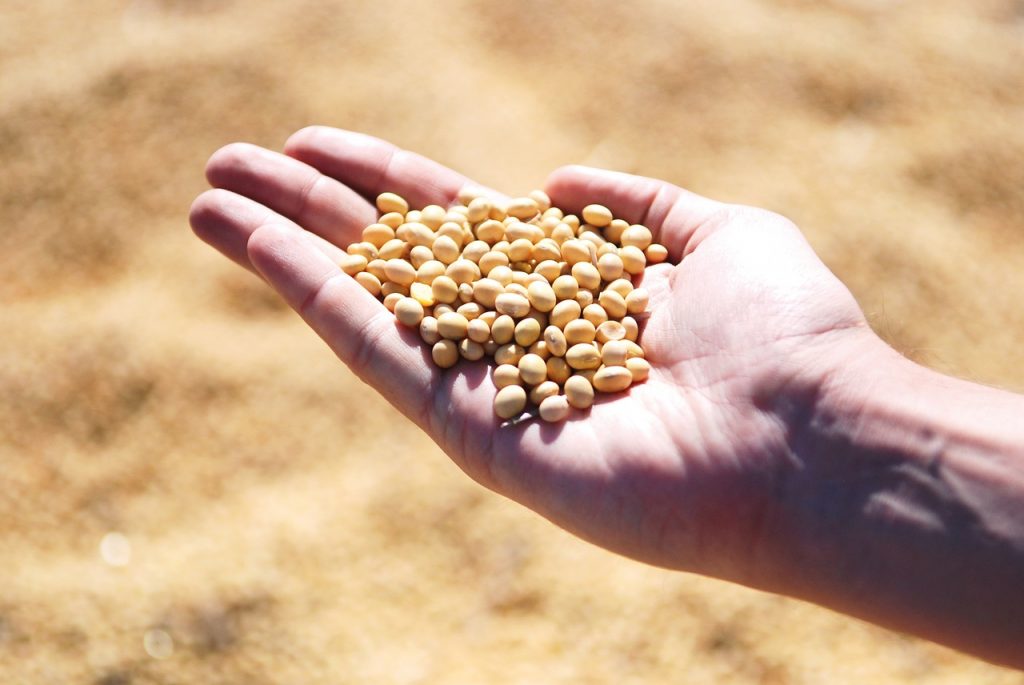Mung Beans
Mung beans are small green beans that belong to the family of legumes. Native to India and East Asia, mung beans have been used for centuries as nutritious ingredients in various dishes. These beans are packed with essential amino acids, vitamins, minerals and fiber, which makes them perfect candidates for protein sources in plant-based patties. One of the most popular names in plant-based patties industry, Beyond Meat, upgraded its meatless patty with the pea, mung-bean, and rice protein. Recent research also shows that mung beans can also aid in bone health. Demand for mung beans, as you can imagine, will be increasing exponentially as popularity of plant-based foods proliferates. Fuji Plant Protein Labs, according to vegconomist.com, recently announced the launch of MuPI/ Glucodia®, its mung bean-based plant protein isolate, into the commercial foodservice, processed foods, and sports supplement markets.
Yellow Peas
Also coming from the family of legumes, Yellow Peas have been used as a source of vegan protein for decades now. Great thing about these legumes is that they contain all nine essential amino acids, which makes them a perfect plant-based source of a complete protein. Pea protein is also a good source of iron and it has a low glycemic index. About 90% of the plant-based burger patties on the market today contain Pea protein isolate as the main source of protein. Outside Magazine even named it “The Best Protein.” Recent launch or “Protein Patties” by Trader Joe’s is an example of a meatless patty that successfully utilizes pea protein isolate. Nestlé’s new Awesome Burger Patty also contains Pea protein as their “The yellow split peas segment is projected to grow at the highest CAGR between 2020 and 2025. The high protein content and ideal amino-acid profiles make yellow split peas an ideal source of pea protein in the industry. Yellow split peas have the highest protein content in the legume family” according to prnewswire.com. Considering all these trends in protein sourcing, we can expect popularity of Yellow peas, green peas and various blends of their protein isolates to only grow in the near future as demand for plant-based patties and foods grows.
Soybeans

Most of us are familiar with this legume and have tried it in a form of Tofu, Edamame, Miso, or Tempeh. Soybeans are a good source of protein and nutrients. In fact, soy products contain a complete source of protein. They are rich in Iron, Manganese and low in fat and carbs. Soy protein in plant-based burger patties is usually in a blended form. Soy patties are nothing new and have been around since the introduction of a veggie burger. Some new age plant-based burger patties are utilizing Soy Protein Isolate as a source of protein and in most cases blending it with either pea, potato, or mung protein isolates. A perfect example of a protein blend that contains a Soy Protein Isolate is the Impossible Burger patty. Although a large number of faux meat patties do utilize soy protein, there has been a lot of debate lately about whether or not soy protein is good for consumption in larger quantities. Claims like, “Soy protein can cause hormonal imbalance” or “GMO soy is not healthy for you” are common, dietitians and biochemists have disproved most of them although there are still two schools of thought amongst consumers.
Seitan
Seitan is also known as wheat protein, wheat gluten, wheat meat, etc. This popular ingredient is not some recent culinary invention although many people are finding out about it now when the rise of veganism is a global trend. Seitan has been used in food preparation for centuries. The earliest documented use of this protein source, according to food historians, dates to the 6th century when it was by Buddhist monks. The name itself is derived from Japanese, “Sei” which translates into “Made from” and “tan” with its root in “tanpaku” which means protein. Seitan is an attractive vegan protein source because of its blandness which allows vegan chefs to manipulate its taste to a desired pseudo meat flavor. Seitan’s texture mimics the texture of meat (chicken, turkey, or lamb) which makes it a perfect candidate for meat substitutes. Seitan is rich in protein,(although it lacks some essential amino acids so it is often enriched with other plant-based proteins), low in carbs, contains loads of B vitamins as well as potassium, iron, and calcium. Seitan is used widely in the preparation of meatless patties nowadays brands like utilize If you are a home chef who likes to prepare his or her vegan patties then perhaps you should consider implementing seitan as a protein source. Of course, gluten is a word that scares many people away these days because of its connection to wheat allergies, celiac disease, and gluten intolerance. People who do have any of these conditions should consult a healthcare professional and get advice on whether or not they should use alternative protein sources. To learn more on how is Seitan made, please visit this link or watch this video.
For a cool and tasty “Seitan Burger” Recipe, please take a look at this video by our friend, chef Sauce Stache from California.
Takeaway
With a rapid rise of plant-based edible products and meat substitutes, demand for protein sourcing is greater than ever. Manufacturers of meatless patties are competing amongst themselves on who will produce a better tasting, more nutritious, and healthiest plant-based patty. This will result in not only a better final product but also better protein sourcing methods and manufacturing.

